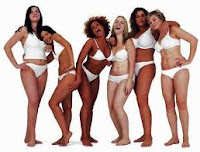Jean Kilbourne, feminist author, speaker, and filmmaker, is internationally recognized for her work on the image of women in advertising. One of the examples is her movie Killing Us Softly, which shows women role in advertising. Kilbourne explains, that advertising sells not just a product, but also sex, violence and beauty, as an indirect action message (Hanson). There is the same pattern showing women in advertising, which is either flawlessly beautiful and thin, which is impossible to achieve in real life, violently dominated by men or wild and animal-like. Men are represented in advertising with less related to the body criticism.




It is much more common to see an add with models like Victoria Secret, which are shown as perfect, skinny and beautiful. These are the adds we basically grew up on. They represent a wrong view of the women, making a pressure on young girls who think they all should look like Victoria Secret models. Lately, commercials with different body types and skin color women started appearing in our lives. Much more women can rely to this kinds of adds and start loving their body the way it is. These women look more natural and much happier than skinny perfect models. This kind of advertisement is still very relatively rare, but hopefully advertising will keep on and not be afraid to show true women bodies.




Another pattern seen in advertising is showing women as animals, which are not only passive, but as always sexy and of course perfect looking. Men are also sometimes represented in animal skin, but they are shown as strong and powerful with no inclination and pressure of having ideal body. This is the major difference between men and women portrayed in the adds. Even if men are shown on the leash held by a woman, men's body structure, ideal or not, is not accentuated. Woman, however, is shown with a perfect half of the body, red panty hose to attract attention and of course heels. No matter what is being advertised and who is advertising it, women are always shown perfect.


The biggest issue for me in advertising is violence shown against women. This teaches men that it's ok to be violent and use force against women. Women don't object to it in adds, they even look like they like it, and still look hot and perfect. In the Dolce & Gabbana add a man is holding a woman on the floor while three other men are watching him. Another add by Dolce & Gabbana is showing a similar situation with a naked man on the floor and four men watching him. There is, however, a huge difference between these two adds, which is that nobody is forcing or violently holding the man to lay on the floor. As shown, men can do whatever they want.


Men are not only shown as serious, important, wearing suits and making money, but are also almost always shown in a physical hierarchy being on top of the women, who are as always sexy, perfect and passive. In a rare kind of add, where a man in the suit stays between woman's legs under her knees, there isn't even a chance to argue that man is taking a lower position and the woman has a higher. Even though the men is tiny in comparison to the woman, it's not the message the add is sending. The man is in the suit and is holding a magazine with a cover of a woman wearing a red bra. Red leather boots the woman is wearing are openly suggesting that the top of that woman is not better than the magazine cover. Therefore, by pretending to put men in the lower position as women are, women are still seen at the end as a lower level.
Advertising, which is growing and expending, is very dangerous, according to Kilbourne. It is like a monster who is destroying or damaging people's minds, views and behaviors. The stereotypes used in advertising will be very hard to change or get rid of. Beauty, sex and violence are brand images, which are not only selling the product, but also selling themselves, ideas and planting them in people's minds (Hanson). Advertisers should change their tactics and big ideas, and find alternative paths to sell their products (Hanson). They, however, create a different and impossible world to promote their products, which they think people want to see. They should try different methods and maybe that will prove not only to be better for women, but for the product as well.
Works cited:
Kilbourne, Jean. Killing Us Softly.
Hanson, Ralph. Mass Communication. Living in a media world.
Pictures used (in the order they are shown): 1, 2, 3, 4, 5, 6, 7, 8, 9, 10, 11, 12
I actually used the same image for the alcohol advertisement with the woman between the man's legs. Everything and everyone is about sex especially when it is related to alcohol. It is just easier to use this kind of market strategy to promote alcohol. Using women as an iconic sex figure inferior to men will never cease to exist at least not in this era. Many people like the idea that men are not equal to women even though it is the 21st century. In all these advertisements, women is shown as sex figures and as objects like you mentioned. Objects? I don't think this will ever change. Women is always shown as vulnerable and easy to push around. They should have more advertisements with women being the authority and as a person worth respecting and not using.
ReplyDelete